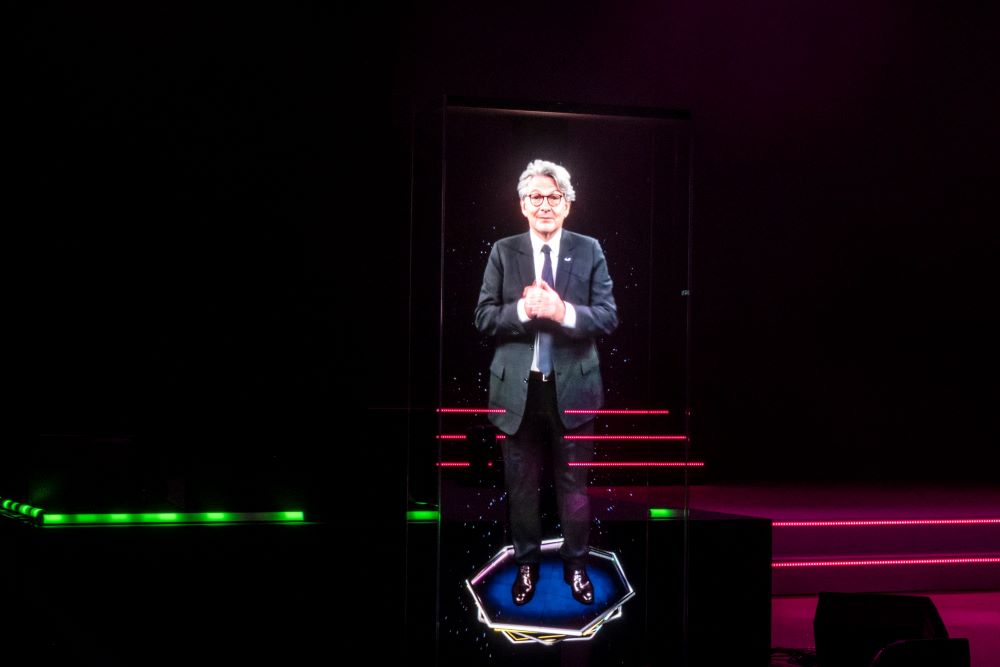Holography, virtual reality and augmented reality are becoming more mainstream in business and commerce. Holograms are providing users with extra information, or even helping create a brand-new digital world entirely. These cutting-edge technologies allow companies to place themselves ahead of their competition and lead the customer-engagement race.
Digital avatars and holographic humans fill the “interaction void” between humans and the digital and physical worlds. The variety of virtual states creates the so-called mixed-reality spectrum, which includes the following:
- Near-digital experiences
- Near-physical experiences
- Mixed-reality experiences
As a part of mixed reality, holographic display technology can be used in all sorts of areas. Fundamentally, virtual and augmented realities are substantially similar, although brands often use them quite differently and, in some cases, you cannot replace one with the other. Let’s explore both.
Virtual Reality vs. Augmented Reality
Virtual reality is indispensable for complex simulations when there is no other way to reproduce specific reality conditions. Meanwhile, augmented reality is increasingly used for product modeling and extending reality with extra data.
A good example of when virtual reality might be used would be someone checking into a hotel or making a deposit at a bank. There are some parts of the interaction, such as name and details, that are easy to script. However, there are other parts that require a genuine human interaction. When the second part is essential, this can now be done via a call center or central location using a livestream and green screen. Thus, organizations can be far more efficient while still providing that personal service.
Many brands are looking for more control over the way that their products are created and sold. Establishing strong communications between those brands and their end users adds even more value to the brands and their product offerings.
Retailers are also keen to develop their customers’ in-store experience so as to provide a reason to come back to brick-and-mortar stores. Interactive advertising or interactive promotions have the power to create extraordinary consumer experiences, thereby giving retailers the ability to connect with consumers on a completely different level.
Interactive advertising — from traditional quizzes to virtual and augmented reality — is actively used by some of the biggest brands in the world, including IKEA, Lego, Coca-Cola, McDonald’s, Volkswagen and many others.
Demand for Digital Humans
So, what does this mean in terms of the future and which specific technologies we should watch out for? Leading brands in holographic technology are seeing more and more demand for digital humans. Some initial iterations were based on pre-recorded 3D holographic green-screen videos of real people, but they were not fully interactive. You might have seen demonstrations of this involving executives from Integrated Systems Europe or AVI-SPL.
With holography’s value having been well established, prospective clients soon began asking providers if it was possible to further develop this technology to create the possibility of a 3D holographic livestream. And, indeed, these capabilities are now starting to blossom. This aligns with brands and events increasingly looking to bring a higher level of personalization and interactivity while retaining the human look and feel.
But digital humans are just one piece of the interactivity puzzle. The options are endless. The key is to look at what you already have and build atop that. At this point, we are all in the Zoom and Teams era; they are so deeply integrated into our lives that we can’t live without them. At the same time, flatscreen images are just not the same as a 3D image or person in front of us.
Live 3D Holographic VC
This is why leading brands came up with the livestreaming feature for their technology. Therefore, I ask a simple question: Can live 3D holographic VC be that far away?
It all seems pretty simple, but transmitting the image is just one part of a complex solution. It’s necessary to enhance the holographic image with added layers and visual effects to ensure the hologram appears realistic. This is done to convince the human brain that the digitally streamed person is physically in front of them. The addition of these layers provides the magic moment…the moment when digital technology blends with reality and brings forth a digital and emotional connection. This simply wasn’t possible previously.
A similar thought process lies behind 3D-modeler solutions. Traditional forms of brand advertising aren’t delivering the look and feel that high-end brands are now looking for. A good example is car brands, which, for a long time, used 2D videos or static images. Now, however, these techniques are being replaced, regardless of how amazing the photography might be. Instead, leading brands are exploring the 3D-modeling world and providing the ability to rotate and add/remove layers with touch-free hand gestures.
While this is just the first iteration of these applications, there’s strong reason to believe that this will lead to even more customization and interactivity in this field.
To check out previous Commercial Integrator content from and about HYPERVSN, check out our website archives.
Kiryl Chykeyuk is CEO and co-founder of HYPERVSN.






































